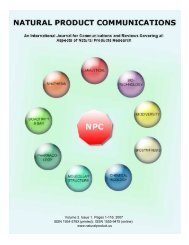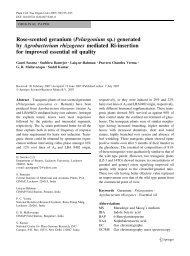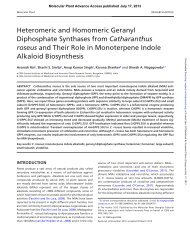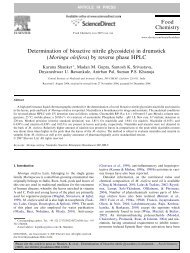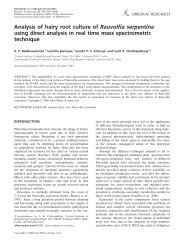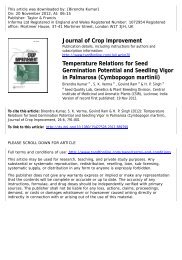Agrobacterium rhizogenes-mediated transformation of ... - CIMAP Staff
Agrobacterium rhizogenes-mediated transformation of ... - CIMAP Staff
Agrobacterium rhizogenes-mediated transformation of ... - CIMAP Staff
- No tags were found...
You also want an ePaper? Increase the reach of your titles
YUMPU automatically turns print PDFs into web optimized ePapers that Google loves.
170 Plant Biotechnol Rep (2007) 1:169–174<br />
attention has already been focused towards developing<br />
production alternatives <strong>of</strong> root-derived phytomolecules in<br />
order to meet the growing demand <strong>of</strong> pharmaceutical<br />
industries. The role <strong>of</strong> <strong>Agrobacterium</strong> <strong>rhizogenes</strong>-<strong>mediated</strong><br />
‘‘hairy root’’ cultures as an efficient production<br />
alternative has undeniably proved its effectiveness in the<br />
worldwide arena (Guillon et al. 2006a, b; Hu and Du<br />
2006). The stride <strong>of</strong> hairy root technology from the<br />
boundaries <strong>of</strong> research laboratories to industrial-scale<br />
production strategies has magnificently been manifested<br />
through the advent <strong>of</strong> the German company ROOTec<br />
(http://www.rootec.com), devoted fully towards up-scaling<br />
the hairy root technology as a production alternative at the<br />
industrial level for two important phytomolecules <strong>of</strong><br />
endangered plant origin.<br />
In the backdrop <strong>of</strong> these developments and in continuance<br />
to our earlier research effort (Verma et al. 2002), it<br />
was felt essential to focus our analogous research attention<br />
towards another very important and critically endangered<br />
medicinal plant species, i.e., Picrorhiza kurroa, which<br />
yields clinically proven hepato-protective and immunomodulating<br />
glycosides in its underground parts (Anonymous<br />
2001; Gupta et al. 2006).<br />
Picrorhiza kurroa Royle ex Benth belongs to the<br />
family Scrophulariaceae and is an endemic plant <strong>of</strong> the<br />
alpine Himalayan range <strong>of</strong> India. The roots and rhizomes<br />
<strong>of</strong> 3–4-year-old P.kurroa plants yield a crystalline<br />
product called ‘‘kutkin,’’ which is usually a mixture <strong>of</strong><br />
two major C9-iridoid glycosides, i.e., picroside-I (6-O<br />
-trans cinnamoylcatalpol) and kutkoside (10-O-vaniloylcatalpol)<br />
(Kumar et al. 2004). Significant hepatoprotective,<br />
anticholestatic, antiulcerogenic, antiasthematic,<br />
antidiabetic, anti-inflammatory and immuno-regulatory<br />
functions have already been ascribed to these glycosides<br />
for which the extracts <strong>of</strong> the underground parts <strong>of</strong> this<br />
plant finds applications as the major component in several<br />
Indian herbal preparations (Ram 2001; Thyagarajan<br />
et al. 2002).<br />
In order to address the problem <strong>of</strong> unregulated trade <strong>of</strong><br />
the underground parts <strong>of</strong> P. kurroa and to impede the<br />
adulteration <strong>of</strong> the raw materials to be used for herbal<br />
preparations, it seems highly desirable to explore the immense<br />
potential <strong>of</strong> the hairy root system <strong>of</strong> this presently<br />
unexplored medicinal plant species. This communication<br />
highlights the significant progress made in the afore-mentioned<br />
directions that have helped to address the concern<br />
involving this particular endangered medicinal plant species<br />
P. kurroa through the establishment and selection <strong>of</strong><br />
fast-growing, high-yield hairy root clone(s). The current<br />
research findings will help in bringing the prospect <strong>of</strong><br />
achievable, root-derived phytomolecules from hairy root<br />
cultures <strong>of</strong> P. kurroa another step closer to industrial<br />
exploitation.<br />
Materials and methods<br />
Induction and establishment <strong>of</strong> hairy roots<br />
Picrorhiza kurroa plants (8–10 weeks), maintained under<br />
in-vitro conditions on semisolid MS (Murashige and Skoog<br />
1962) medium supplemented with 2.0 mg L –1 BAP and<br />
0.1 mg L –1 NAA, were used as the explant source. The<br />
young leaves and stem segments were inoculated through<br />
pricking with a 48-h-old suspension culture <strong>of</strong> A. <strong>rhizogenes</strong><br />
strains, namely LBA 9402 and A 4 (kind gift from<br />
Pr<strong>of</strong>. D. Tepfer, INRA, Versailles Cedex, France), grown<br />
in liquid YMB (Hooykass et al. 1977) medium (O.D 600 =<br />
0.9–1.0). After 48 h <strong>of</strong> co-cultivation with the individual<br />
bacterial strain, the explants were transferred onto the same<br />
respective medium containing 1.0 g L –1 <strong>of</strong> cephalaxin<br />
(Ranbaxy, India) under dark conditions. Similar types <strong>of</strong><br />
explants, pricked with a sterile needle devoid <strong>of</strong> the bacterial<br />
suspension, were cultured under uniform conditions<br />
as controls. The emerging hairy roots were subsequently<br />
transferred to the half and full strengths <strong>of</strong> the B 5 medium<br />
(Gamborg et al. 1968) containing 3% (w/v) sucrose for<br />
their further proliferation. Once established, the individual<br />
hairy root clones were transferred to liquid B 5 medium<br />
with the same concentration <strong>of</strong> antibiotic and incubated on<br />
a rotary shaker in the dark at 25 ± 1°C under constant<br />
agitation (80 rpm). The antibiotic concentration was progressively<br />
lowered and finally completely omitted after<br />
4 months. The crushed hairy root extracts were streaked on<br />
semisolid YMB medium to check for the presence <strong>of</strong><br />
A. <strong>rhizogenes</strong> at this stage. Roots excised from in vitrogrown<br />
complete plantlets <strong>of</strong> P. kurroa were cultured under<br />
identical conditions in liquid B 5 medium supplemented<br />
with 1.0 mg L –1 IBA to serve as control roots.<br />
Growth kinetic studies<br />
The growth characteristics <strong>of</strong> 25 independently generated<br />
hairy root clones were evaluated on the basis <strong>of</strong> total root<br />
elongation (cm), lateral branching per centimeter <strong>of</strong> primary<br />
roots and fresh weight (FW) increment after 15 days<br />
<strong>of</strong> incubation in full- and half-strength liquid B 5 medium<br />
containing 3% sucrose. On the basis <strong>of</strong> the apparent growth<br />
behaviors with respect to these specific parameters, nine<br />
individual root clones were selected for further studies.<br />
All nine hairy root clones and the control, non-transformed<br />
roots were subjected to growth kinetic analysis for<br />
growth kinetic studies, 100 mg <strong>of</strong> actively growing hairy<br />
roots from 15 days old cultures were transferred to 250-ml<br />
Erlenmeyer flasks containing 50 ml <strong>of</strong> half-strength B 5<br />
medium with 3% sucrose, and their growth performances<br />
were determined following the method described earlier<br />
(Verma et al. 2002). The selected superior hairy root clone<br />
123




